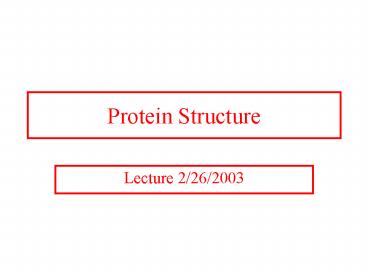Protein Structure - PowerPoint PPT Presentation
Title:
Protein Structure
Description:
Zinc fingers. C2H2 zinc finger: It is characterized by the sequence CX2-4C... C4 zinc finger: Its consensus sequence is ... zinc finger. Zinc ... – PowerPoint PPT presentation
Number of Views:74
Avg rating:3.0/5.0
Title: Protein Structure
1
Protein Structure
- Lecture 2/26/2003
2
beta sheets are twisted
- Parallel sheets are less twisted than
antiparallel and are always buried. - In contrast, antiparallel sheets can withstand
greater distortions (twisting and beta-bulges)
and greater exposure to solvent.
3
The twist is due to chiral (l)- amino acids in
the extended plane. This chirality gives the
twist and distorts H-bonding. A tug of war exists
between conformational energies of the side chain
and maximal H-bonding.
4
(No Transcript)
5
Two proteins exhibiting a twisting b sheet
Bovine carboxypeptidase
Triose phosphate isomerase
6
Connections between adjacent b sheets
7
Sheet facts
- Repeat distance is 7.0 Å
- R group on the Amino acids alternate up-down-up
above and below the plane of the sheet - 2 - 15 amino acids residues long
- 2 - 15 strands per sheet
- Ave of 6 strands with a width of 25 Å
- parallel less stable than anti-parallel
- Anti-parallel needs a hairpin turn
- Tandem parallel needs crossover connection which
has a right handed sense
8
Non-repetitive regions
Turns - coils or loops link regions of secondary
structure 50 of structure of globular proteins
are not repeating structures b bends type I and
type II hairpin turn between anti parallel sheets
9
Reverse Turns
Type I f2 -60o, y2 -30o f3 -90o, y3 0o
Type II f2 -60o, y2 120o f3 90o, y3 0o
10
two-residue turns
11
Protein Structure Terminology
12
Folding motifs (super secondary structure)
Certain amino sequences have patterns to their
folding. A. bab motif,
B. b hairpin C. aa motif
13
beta-alpha-beta
- parallel beta-strands connected by longer regions
containing alpha-helical segments - almost always has a right-handed fold
14
Helix-turn-helix
- loop regions connecting alpha-helical segments
can have important functions e.g. EF-hand and
DNA-binding - EF hand loop 12 residues
- polar and hydrophobic a.a. conserved positions
- Glycine is invariant at the sixth position
- The calcium ion is octahedrally coordinated by
carboxyl side chains, main chain groups and bound
solvent
15
Protein Folds
There is an estimate of about 10000 different
folding patterns in proteins About half of the
proteins fall into a few dozen folding
patterns. Those proteins related by structure
are called families. A large Family are the c
cytochromes (see Figure 6-31 pg 147 in FOB.)
16
The b barrel has several types of structures that
have been mimicked in art. A. rubredoxin B.
Human prealbumin or porins C. Triose phosphate
isomerase
17
Concanavalin A
Mostly a b barrel motif
18
Carbonic anhydrase
H2CO3 - ? CO2 H2O
19
Nucleotide binding-Rossmann Fold
20
Glyceraldehyde-3-phosphate dehydrogenase Binding
NADH in the Rossmann fold.
21
Zinc fingers
- C2H2 zinc finger It is characterized by the
sequence CX2-4C....HX2-4H, where C cysteine, H
histidine, X any amino acid. - C4 zinc finger Its consensus sequence is
CX2CX13CX2CX14-15CX5CX9CX2C. The first four
cysteine residues bind to a zinc ion and the last
four cysteine residues bind to another zinc ion - C6 zinc finger. It has the consensus sequence
CX2CX6CX5-6CX2CX6C. The yeast's Gal4 contains
such a motif where six cysteine residues interact
with two zinc ions
22
C2H2 zinc finger
23
Zinc Finger DNA-binding
24
Summary Chapter 6
- Four levels of protein structure
- Primary
- Secondary
- Tertiary
- Quaternary
- Peptide bond (w bond)
- Sheets and helices (f and y bonds)
- Tertiary structure (fibrous or globular)
- Structure determination and fold space
- Protein folding discussed after kinetics -lecture
19































